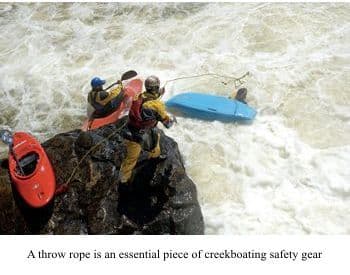Creek Boating Safety Equipment
Creekboating is as much a game of strategy as it is a sport. Half of your time on creeks is spent scouting, and half of the fun comes from picking lines based on how you predict the river will affect your kayak. In this way, creekboating is a lot like a game of chess, and, like chess, there are some important rules that need to be understood. In this article, we're going to look at the unwritten rules that relate to the equipment you should bring on the creek.
The safety equipment considerations for creekboating are somewhat different from those for other types of paddling. Pinning now becomes a main hazard, along with the bodily trauma caused by hitting rocks. One good thing is that most incidences happen within an arm or rope's length from shore, so rescuers can often play a greater role. This is why it's absolutely vital that all creekboaters be trained in swiftwater rescue and first aid. The skills you'll learn could save someone's life someday, including your own!
Creekboats are designed to be as safe as possible in steep, shallow whitewater. "Creekboat" is a generic term that refers to any short boat with lots of rocker and lots of volume in its relatively blunt ends-features that cause the boat to resurface very quickly and to bounce off any rocks that it encounters. If you've already spent time on creeks, then there's a good chance you've seen experienced paddlers using playboats on them. It's important to understand that this does not mean that it's a wise thing to do. A playboat simply doesn't give you the same margin for error that a creekboat does.

Unlike big water paddling, creekboating involves a lot of land-based safety. This gives rescuers the opportunity to use a wider range of safety equipment. We'll be looking at different scenarios and how this equipment can be used in future "Rescue" related articles, but for now, it should be re-stated that the best thing to do is take a swiftwater rescue course. With that said, here's a short list of some safety gear that can come in really handy.
- A first aid kit is great to bring along for obvious reasons.
- A throw bag is your best friend on the creeks and should go everywhere with you. This means that you should carry it even when you're scouting. You just never know when you'll need it.
- Because creeks are so shallow, your paddle will take abuse. A breakdown paddle stored in the back of your boat can mean the difference between being able to paddle out or having no option but to make a heinous hike or climb out.
- A pin kit has the tools you need to pull equipment that is pinned by the water out of a creek. This could include an empty or populated kayak that is pinned. A pin kit has the pieces necessary to clip onto a boat and pull it out, either by simply pulling on it, or by using a more complex system that offer a mechanical advantage-like a Z drag.
- Good quality river shoes offer two advantages; they let you travel most safely along the shoreline, and they provide valuable protection if you find yourself swimming in a creek.
- A rescue vest is a PFD that has a number of built in features, such as a quick-release harness system that can be used for towing or for more advanced rescues such as tethered rescues.
- Elbow pads offer great protection in any type of shallow water and are highly recommended, especially on more difficult and steeper creeks, where you are often traveling at significant speeds.
Of course, every creek is unique and provides its own challenges, but the safety equipment we just mentioned doesn't take up a lot of space in a creek boat, and there really isn't a reason not to bring it. As Murphy's Law would have it - if you don't bring it, you're going to need it.
Related Articles
Where I am temperatures are dropping, so it's almost dry suit weather. With that here's a video with…
Do you need a tetanus shot? We use these as preventive measures to keep more serious problems from…
By Tom Watson I contend, and will steadfastly debate, that the knife is the second most vital tool…
A kayaking buddy, we'll call him "Ben", is one heck of a paddler. He's got years of big, blue water…


